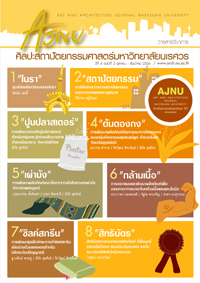ศูนย์ส่งเสริมวัฒนธรรมโนรา
Main Article Content
Abstract
การศึกษาทำวิทยานิพนธ์ครั้งนี้ เป็นการทดลองทำการศึกษาการออกแบบสถาปัตยกรรมด้วยกระบวนการตั้งต้นที่ อาศัยข้อมูลงานวิจัยด้าน ประวัติศาสตร์ มนุษย์ศาสตร์ และสังคมศาสตร์ ในการศึกษากิจกรรมทางวัฒนธรรม เช่น การละเล่น โนรา และการละเล่นโนราโรงครู มุ่งศึกษาในประเด็นเรื่องกิจกรรมการใช้พื้นที่เฉพาะของวัฒนธรรมโนราที่มี ความเชื่อเรื่องตา ยายโนรา ประเพณีโนราโรงครู อันเป็นกิจกรรมสาธารณะของคนลุ่มน้ำทะเลสาบสงขลา ส่งผลต่อเนื่องให้เกิดการศึกษาลักษณะ ทางสถาปัตยกรรมที่เป็นอาคารสาธารณะของพื้นที่ลุ่มน้ำทะเลสาบสงขลา กรณีศึกษา โรงโนรา, โรงครู, อุโบสถ, โรงธรรม และ ศาลา มุ่งศึกษาในประเด็นเรื่องลักษณะทางสถาปัตยกรรม ที่ได้อิทธิพลต่างๆ ในพื้นที่ที่มีความสัมพันธ์เกี่ยวโยงกับวัฒนธรรมโนรา ซึ่งเกิดจากกลุ่มคนที่อยู่ในพื้นที่ดั้งเดิม จากนั้นจึงนำข้อสรุปดังกล่าวเข้าสู่กระบวนการวิเคราะห์สรุปโปรแกรมเพื่อการออกแบบ สถาปัตยกรรมในขั้นถัดไป ผลการศึกษาและการออกแบบ แสดงถึงที่ว่างทางสถาปัตยกรรมในลักษณะที่สัมพันธ์ไปกับ สภาพแวดล้อมธรรมชาติ โดยอาศัยการใช้ที่ว่างที่เป็นสาธารณะของท้องถิ่นเดิมในอดีตมาออกแบบ ตั้งแต่หน่วยเล็กที่สุดของที่ว่าง ไปจนถึงหน่วยใหญ่ระดับผังโครงการ มีรูปแบบที่เรียบง่าย สวยงาม การดูแลของคนในพื้นที่ง่าย ลดการใช้พลังงานในอาคาร และ ประยุกต์ให้เข้ากับสภาวะของวัฒนธรรมท้องถิ่นในปัจจุบัน โดยยังคงแสดงออกถึงเอกลักษณ์ของงานสถาปัตยกรรมท้องถิ่นไว้ได้ การออกแบบครั้งนี้เป็นการทดลองออกแบบจากแนวทางเลือกหนึ่ง โดยยังมีอีกหลายทางเลือกที่สามารถนำมาใช้ออกแบบเพื่อให้ งานสถาปัตยกรรมสามารถช่วยเสริมสร้างความเข้าใจทางด้านวัฒนธรรมท้องถิ่นต่อไป
Nora cultural center
This dissertation is a pilot architectural study that design project based on document research of history, human science, and social science covering the study of cultural activities such as Nora performance and Nora Rong Kru performance. It emphasized in the specific activities’ utility area of Nora culture consisting of respect ritual toward their ancestor worship (Ta-Yai Nora or Grandfather and Grandmother Nora) and Nora Rong Kru Ritual which are the public activities’ area of people around Songkla Lake Basin. These caused the architectural study of public buildings at Songkla Lake Basin. The case study is made up of the architectural structure of Nora Hall, Kru Hall, Ubosot, Sermon Pavilion and Pavilion affected and related to Nora culture which was came from local people. The conclusion, then, was analyzed for the architectural design process.
The result of the study and design showed that the architectural space relates to the natural environment. The space of old vernacular architecture was used for the smallest space design to the biggest one such as project plan. The design pattern was simple, beautiful, easy to take care, reducing use of indoor energy and applying to suit for recent local culture. It, however, shows the identity of vernacular architecture. This design is one of several options using for other architectural designs which help to promote the future cultural understanding.

